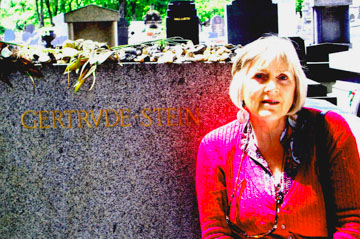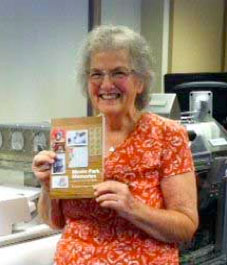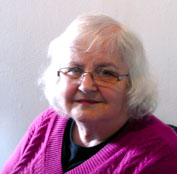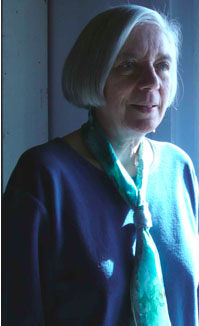Jennifer O’ Neill Pickering, Diane Lovegrove Bader, Marilynn Price, Patricia Nichol, Melen Lunn, Sarah Stricker
![]()
The Writers’ Circle is a writing group that has been meeting at the Sacramento Poetry Center to critique each other’s prose and poetry, for several years. The group began after all of the original members attended a writing workshop led by Julia Connor. They have published one anthology, The Writers’ Circle, poetry and prose v.1.
Jennifer O’Neill Pickering is an award winning artist, a writer, and teacher living in Sacramento, CA. Her poem, I Am the Creek, is included in the Sacramento site-specific sculpture, Open Circle. Some of her publishing credits include: Restore/Restory : a people’s history of the Cache Creek Nature Preserve, Occupy Wall Street Anthology, Munyori Literary Journal, Tiger’s Eye Journal, Heresies, WTF, PoetryNow, and Medusa’s Kitchen. She is published by Harlequin. The photograph is taken at Gertrude Stein’s grave in Paris.
Artemisia
My mother is born in
the time of rebirth
named after
the moon goddess,
huntress of the woods
twin to Apollo.
In an apprenticeship of boys,
is a father’s favorite,
studies Caravaggio,
masters chiaroscuro,
describes the delicacy of Tuscan light,
is chemist of Hematite and Ochre.
Like her sister artists:
Lavinia, Diana, Elisabetta,
does not embroider pillows
royalty kneel upon
seeking absolution.
She births images of the Madonna,
her child, the one called the Messiah,
paints stories of women of myth and bible:
Susanna e i Vecchioni,
Giuditta che decapita Oloferne,
and though tears are a good binder
sweat… is… better.
Wed to the brush,
possesses a steady hand,
burnished with passion,
nurses five children,
is gifted beyond her womb
scorned by clergy,
caned by righteousness.
Pregnant with imagination,
wears smocks
stained in linseed oil,
scaffolds her way to heaven
signs her name to canvases
from Rome to London.
Though, she’s told since childhood,
women are of Adam’s rib,
my mother is not broken,
is not forgotten.
— Jennifer O Neill Pickering
Artemesia Gentileschi was a Tuscan female painter of the 16th century and lived: July 8, 1593 – 1653 (17th century). She was raped by her teacher and then, tortured by the Catholic Church. She later had an arranged marriage with another painter and had five children. Only her daughter, Palmira survived. She separated from her husband. Her patrons included the Medici’s and King Charles. She was friends with Galileo Galilei. Lavinia Fontana, Diana Mantuana, Elisabetta Sirani, were contemporaries.
Diane Lovegrove Bader recently published her book, Menlo Park Memories. It contains prose and poems about her childhood in during the 1940’s on the San Francisco Peninsula. She is currently working on another book about her Irish great-grandparents’ life and she is editor of Crone Chronicles, a newsletter for Wise Women over 50 years of age. Diane, a relative newcomer to the art of writing poetry, enjoys the Writers’ Circle at the Sacramento Poetry Center.
The King’s Highway 1942
El Camino Real threads northward
toward San Francisco
model A chugs along
carries Mama and me
past salt flats, towering eucalyptus
See’s Candy headquarters
ahead looms Tanforan* racetrack
surrounded by high fence
Ford sputters to a stop
next to barbed wire
groups of well-dressed Japanese adults congregate
in front of horse stalls
dark-haired wide-eyed children stare
through barbed wire
Our eyes meet
Why, Mama, why?
— Diane Lovegrove Bader
*In the wake of Imperial Japan’s attack on Pearl Harbor, December 7, 1941, President Roosevelt signed Executive Order 9066 on February 19,1942. It called for all Japanese on the Pacific coast to be sent to War Relocation camps. Tanforan Racetrack in San Bruno, CA, was an assembly center for holding Japanese people until they could be shipped to other places such as Manzanar or Tule Lake. They arrived wearing their best clothes carrying only one suitcase and they lived in horse stalls.
El Camino Real translates as The King’s Highway.
Marilynn Price moved to Sacramento three years ago and began writing poetry. She enjoys traditional and nontraditional forms. She’s recently published in Late Peaches.
On Viewing Edgar Payne’s Solitude’s Enchantment
My goal is to show the bigness of the hills and the beauty of the passing clouds — Edgar Payne
brushstrokes up and down, then across,
create volume, and with volume — time?;
distance shown by thin-air haze,
each mountain layer less defined
mountains ridges stagger back
from the awed and sweeping eye,
rests upon a smooth-stroke pond
ultraviolet in an alpine height,
reflecting ice, rock and meadowlands
whose bees see shock-blue flowers shine
in an echoed space
vibrant above timberline.
— Marilynn Price
Patricia L. Nichol is a writer of poetry and prose and has been published in a number of anthologies, journals, and on-line sites. She has an M.A. in English from Cal. State University, Sacramento, and a certificate in
creative writing from the University of California, Davis.
Lorca’s Lament
I stroke words as the moon ascends
in the summer sky, remembering Jimenez
who was not always himself, but who
always loved his poems which were like
his wife: intense, lovely, lovely . . .
Then she died.
I stroke the handle of the shovel as I dig
near the olive tree; I am digging my grave.
The night is dark and hot, and one
of the others who is to die is already weeping.
Unripe olives above my head: green, green . . .
—Patricia Nichol
Melen Lunn was part of a women’s healing group in 1977, where poems began emerging in her journal. Poetry remains her intrigue and solace. She has been published in Brevities, and has read her poetry in Eugene and Portland, Oregon, Philadelphia, San Francisco, and Sacramento. Melen writes for the California Department of Education.
from the train
a just born calf
wobbles
tugging at mother’s teat
a stream mirrors
rose satin sky
— Melen Lunn
Sarah Stricker has studied with Poets Laureate, Bob Stanley and Julia Connor. She began her studies of Shaman’s Journey under Michael Harner, an internationally known teacher shamanism. One of her ancestors was John Ross, chief of the Cherokee Indian Nation during and after Andrew Jackson’s presidency.








